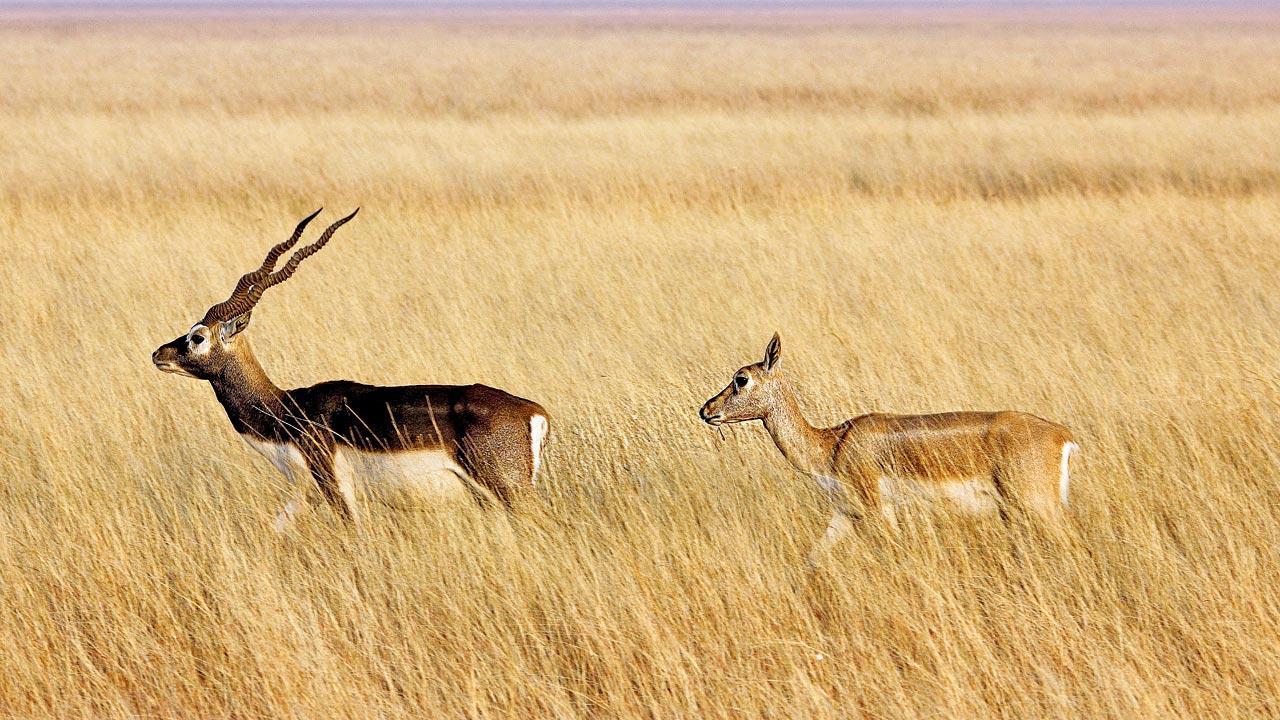Twelve of the special antelopes, found only in the Indian subcontinent, leaped to their death in the state last week. Must we wait till they are irreversibly gone to care?

The blackbuck National Park in Velavadar, Gujarat, is one of the protected areas for the species in the country. Pic Courtesy/Kedar Gore
The poor Indian antelope, with its majestic corkscrew antlers, only makes news when starring in tragedies. A death at the gun of movie stars in 1998, or a fatal leap from a bridge on the Solapur-Pune-Mangalwedha National Highway last week. To naturists, this charismatic, gregarious animal that is unique only to the Indian subcontinent, is a subject of wonder and investigation; a flagship species that denotes the ecological health of its habitat.
ADVERTISEMENT
Naturists say this is just the beginning of the end. The blackbuck is not on the endangered animals list yet. Ananya Jana, a phylogenetics researcher, who based her PhD on the herd animal, estimates that about 30,000 to 35,000 of them exist in the wild currently. “The IUCN [International Union for Conservation of Nature] survey of 2017,” says the Hyderabad-based scientist, “estimated there were above 25,000 blackbucks in India, and an upward trend was estimated.”
The threat to the species comes from the usual bad guys—urban development—but the route taken is a bit more convoluted and insidious. “Blackbucks are grassland creatures,” explains Kedar Gore, Director of The Corbett Foundation, “And in India, since colonial times, we have a narrow view of what an ecosystem is—grasslands aren’t recognised as them as forests are, and thus not granted protected status. They are regarded as wasteland and turned over for development and agriculture easily. But grasslands too are rich in reptiles, birds, grazing animals and their predators.” Scrub and shrub-lands, which would earlier be protected by a king as hunting lands or for grazing livestock, slowly dripped away.
 Kedar Gore
Kedar Gore
Another member of its eco system—such as the cheetah—is already extinct (was, until a new African strain of the wild cat was introduced recently). In fact, the spotted feline was used by royalty to hunt down the antelope for sport before Independence. The wolf, another one of the blackbuck’s natural predators, has moved on to the easier-to-catch sheep, goat and cow that have intruded into its hunting ground along with the spread of agriculture. In fact, the wolf has even changed its hunting strategy: “Once a diurnal creature,” explains Kishor Rithe, director, Satpuda Foundation, “the wolf now hunts in the day and travels up to 150 km a night, knowing humans will retaliate after he steals their livestock. So, one night they are in Ahmednagar, the next, in Beed.” Both the cheetah and the wolf are our antelope’s natural predators, and their absence has contributed to a surge in their numbers.
However, that there is so far no genetic marker of their population decline is not good news. The blackbuck is a highly adaptable species, and that can lead to its downfall. “As human crops take over its natural feeding areas,” says Professor Praveen Karanth, “the blackbuck has started feeding off them, which makes it a pest for humans.” The phylogeneticist at the Centre for Ecological Studies, Indian Institute of Science, guided Jana’s doctorate. Gore says that blackbucks have also adapted to scarce water conditions, and currently they are threatened by wild dogs or the sound of the dhol.
The male of the species move about a lot; the females travel lesser distances, Jana’s research has found. A typical herd will have a dominant buck, a harem of does, and their offspring. On an average, a doe produces one foal a year—after a gestation period of five months; and a herd could have 30 to 300 members. They leap, not run, a move called stotting to escape a predator; which is probably what happened on the highway.
Blackbucks are found abundantly across peninsular India—in Rajasthan where the film unit found them in a now infamous incident; in Latur, Ahmednagar, Vidarbha, Solapur and Kolhapur in Maharashtra, in Gujarat, Orissa, Tamil Nadu, Karnataka and Andhra Pradesh. However, these populations are being fragmented and isolated from each other as development runs through the states.
The solution, says Rithe, is to allot funds for research to map their route and build underpasses and over passes that facilitate safe movement. It’s a mitigation technique that has met with great success abroad and elsewhere in India. “Three underpasses like these exist on the NH7 Nagpur-Jabalpur highway,” says Rithe, “and 15 individual tigers have been recorded using these, as well as 5,000 animals of other species. But the government is waiting for someone to raise this instead of acting proactively.”
And that runs the risk of too little being done, too late.
 Subscribe today by clicking the link and stay updated with the latest news!" Click here!
Subscribe today by clicking the link and stay updated with the latest news!" Click here!







